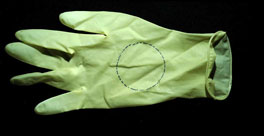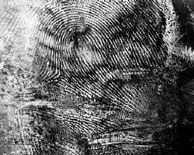Visualization of latent fingerprints on used vinyl and latex gloves using Gellifters
M.J.M. (Theo) Velders
Politie Brabant Zuid-Oost, Eindhoven, the Netherlands
IAI Educational Conference, St. Louis, Missouri - August, 2004
Presenter: J.N. (Jan) Zonjee, BVDA, Haarlem, the Netherlands
See also the instructional videos on "Locating and Collecting Fingerprints"
Introduction
 At a crime scene, we regularly find latex or vinyl gloves which have been left behind by the perpetrators. As crime scene officers, we are then confronted with the question of what to do with these gloves. We know these used gloves can contain fingerprints but how to make them visible?
At a crime scene, we regularly find latex or vinyl gloves which have been left behind by the perpetrators. As crime scene officers, we are then confronted with the question of what to do with these gloves. We know these used gloves can contain fingerprints but how to make them visible?
In most cases such gloves are secured only for DNA investigation. Sometimes there are attempts to make prints visible, usually with chemical methods, but as most of us probably have experienced, the results of chemical methods are usually not very satisfying.
Usually perspiration and the powder in these gloves are blamed for having destroyed the latent fingerprints.
My experiences
Up until 2001, I succeeded only once in my 30 years as a crime scene officer to visualize a fingerprint in a latex glove. I had tried many times to treat disposable latex and vinyl gloves with chemical means, but virtually all these attempts failed to produce a result.
Then in the middle of 2001, a collegue handed me four latex gloves which had been thrown away by burglars when leaving a crime scene. As so often before, I started working on the gloves, treating two of them with ninhydrin and the others with cyanoacrylate fuming. Unfortunately, both methods failed to visualize any prints.
Idea
 After this disappointment, I wondered if it might be possible to get any fingerprints off of these gloves using a black gelatin lifter. With a piece of PVC tubing, stuck in the fingers of each glove, every finger was rolled ten 360° revolutions over a length of black Gellifter.
After this disappointment, I wondered if it might be possible to get any fingerprints off of these gloves using a black gelatin lifter. With a piece of PVC tubing, stuck in the fingers of each glove, every finger was rolled ten 360° revolutions over a length of black Gellifter.
To my amazement, a number of excellent prints were lifted from these chemically treated gloves. I had a strong suspicion that this could be a real breakthrough.
Looking for a solution
Were these results with the four latex gloves a coincidence, or could it be that lifting prints with a Gellifter was the solution to a big problem?
To get more certainty, I started a comparative examination, looking at all the methods that have been mentioned to visualize prints in gloves and at the lifting with the Gellifter.
Researching the internet, I found that collegues around the world have used the following methods:
- ninhydrin and DFO
- iodine
- cyanoacrylate (CA) fuming, usually followed by treatment with fluorescent staining solutions
- sticky-side powder
- gentian violet
- physical developer
These methods gave varying results (see references).
Read the report:
Conclusions
- Fingerprints on vinyl or latex disposable gloves are best recovered by lifting with black BVDA gellifters.
- These fingerprints should not be pre-treated with a chemical method.
- Using this physical method, fingerprints can be lifted till about 10 days after the gloves have been worn, depending on the conditions at which they were kept.
- Somewhat older fingerprints (48 hours) give a better result than fresh marks, provided they have not been kept in extreme conditions.
- Due to the materials that are used in rolling the fingers, the lifted print is larger than an inked impression.
- In the palm area of the tested gloves, no identifiable ridge detail was found, probably due to the friction between glove and hand during wearing.
- The palm area of the glove is therefore ideally suited for securing DNA evidence.
- Methods other than lifting, like chemical treatments using cyanoacrylate, ninhydrin, DFO, iodine, sticky-side powder, and gentian violet, give mediocre to very bad results.
- With sticky-side powder, fingerprints on latex and vinyl gloves were totally destroyed.

